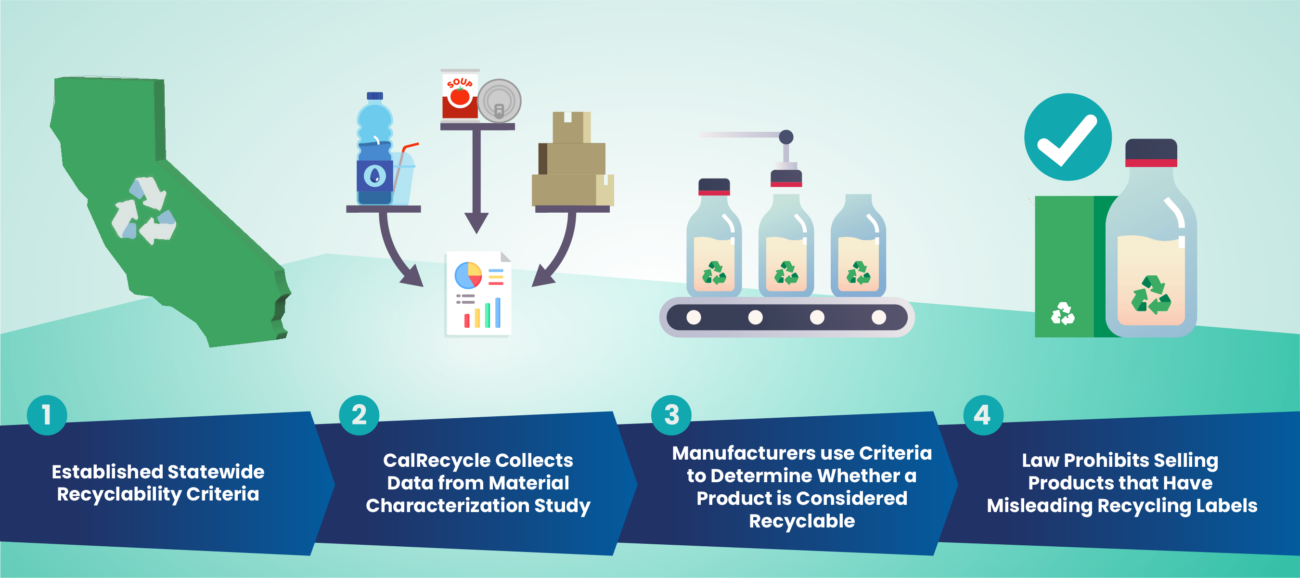Accurate Recycling Labels
Many Californians rely on products’ chasing arrows symbol to tell if it’s recyclable.
Until 2021, California did not set specific criteria for the using chasing arrows recycling logo.
Lawmakers enacted SB 343 (Allen, Chapter 507, Statues of 2021), which prohibits use of the chasing arrows or any other indicator of recyclability on products and packaging unless certain criteria are met.
Increasing recycling in California first requires accurate labels on recyclables.
Identifies What Gets Recycled
SB 343 directs CalRecycle to publish data about the types of materials actually recycled in California. Manufacturers and other interested parties must use that information as part of their assessment of whether products can be considered recyclable for labeling purposes. The law outlaws manufacturers and others from selling products or packaging labeled as recyclable unless the items are regularly collected and processed for recycling in the state.
This will:
- Help vendors and consumers make informed decisions about products
- Provide an objective basis for holding manufacturers, distributors, and retailers responsible for misleading consumers about whether products get recycled
Program News
- CalRecycle released in December 2023 the SB 343 Preliminary Findings Report for the required characterization study of material types and forms study of material types and forms that are collected, sorted, sold, or transferred by solid waste facilities.

Steps to Identify What’s Recyclable
Often referred to by industry stakeholders as the “Truth in Recycling” or “Truth in Labeling” law, SB 343 requires CalRecycle to complete two major steps by January 1, 2024.

Step 1. Study of What Gets Recycled (Material Characterization Studies)
- CalRecycle commissioned a statewide analysis at material recovery facilities in 2023 to identify which materials are commonly collected, sorted, sold, or transferred for recycling in California.
- CalRecycle published a draft of its preliminary findings on December 28, 2023. CalRecycle held an informational session on February 13, 2024, and is currently accepting public feedback.
- CalRecycle will formally publish its preliminary findings after the current comment period. The preliminary findings will formally be presented at a public meeting, and there will be another period for submission of public comments.
The law also requires ongoing studies to make updates to the statewide analysis. The second study will be completed by 2027, with future studies every 5 years after that.
CalRecycle awarded the contract for the 2023 Material Recovery Facility (MRF) Recyclable Material Study, DRR22056 to Cascadia Consulting Group.
Step 2. New Reporting Requirements
CalRecycle will update regulations to require material management facilities and operations to report regularly through CalRecycle’s Recycling and Disposal Reporting System:
- How materials are collected or processed in the state
- Which material types and forms facilities recover and don’t consider contaminants
Program Implementation of SB 343
- 2021 Gov. Newsom Signed SB 343 into Law
- 2022 October-November: Request for Proposals for Material Characterization Study
- 2022 December: Material Characterization Study Contract Announcement
- 2023 Summer: Anticipated Material Characterization Study Field Word
- 2024 January 1: Preliminary findings published: Public comments received via Public Meeting
- 2024 January 1: Regulations Update: Material Recover Facilities Required to Report to CalRecycle
- Final Material Characterization Study Findings Published
- 2025: New Prohibitions Against mislabeling of products
- 2027: Second Material Characterization study findings published
- 2032: Additional Findings published every 5 years
Provides Information to Clarify Mislabeling
Although existing laws make it illegal to use deceptive labels on products, little credible information was available to define accurate and deceptive recycling labels.
SB 343 directs CalRecycle to:
- Research what is collected and processed for recycling in California and
- Publish this information so manufacturers can accurately label products that get recycled.
Local Jurisdictions and the California Attorney General may also use this information when filing civil suits and charging monetary penalties against companies who are not labeling their products accurately. Deceptive labeling is also subject to civil suits pursuant to the Business and Professions Code.
After CalRecycle publishes each new study, manufacturers will have 18 months to ensure the updated information supports the use of the chasing arrows recycling symbol on their products.
Public Feedback
CalRecycle has released the draft SB 343 Preliminary Findings Report for the required characterization study of material types and forms that are collected, sorted, sold, or transferred by solid waste facilities in California.
CalRecycle hosted an informational session on February 13, 2024.
CalRecycle will announce a public meeting to present the draft findings of the preliminary report to the public and to solicit feedback on the draft preliminary study findings. This meeting will include:
- A statutory overview
- Study methodology and
- Preliminary findings.
CalRecycle will publish the final findings report within 60 days of the public meeting.
Public comments can be submitted:
- At the meeting
- Via email to wastechar@calrecycle.ca.gov.
Comments related to the draft SB 343 Preliminary Findings Report are being accepted.
Contact Us
- For updates about SB 343 Material Characterization Study progress, subscribe to the Material Characterization Study Listserv.
- For any waste characterization studies questions, contact wastechar@calrecycle.ca.gov.
- For more information on the rulemaking process regarding updates to the reporting requirements for materials management facilities and operations, visit the CalRecycle Recycling and Disposal Reporting System Regulations Webpage.
For more information contact, the Office of Public Affairs, opa@calrecycle.ca.gov


